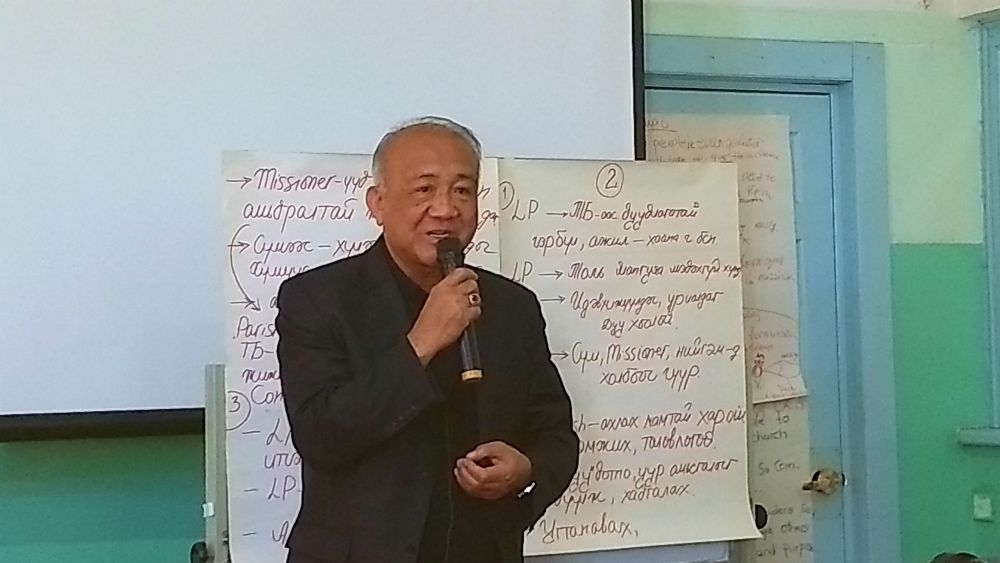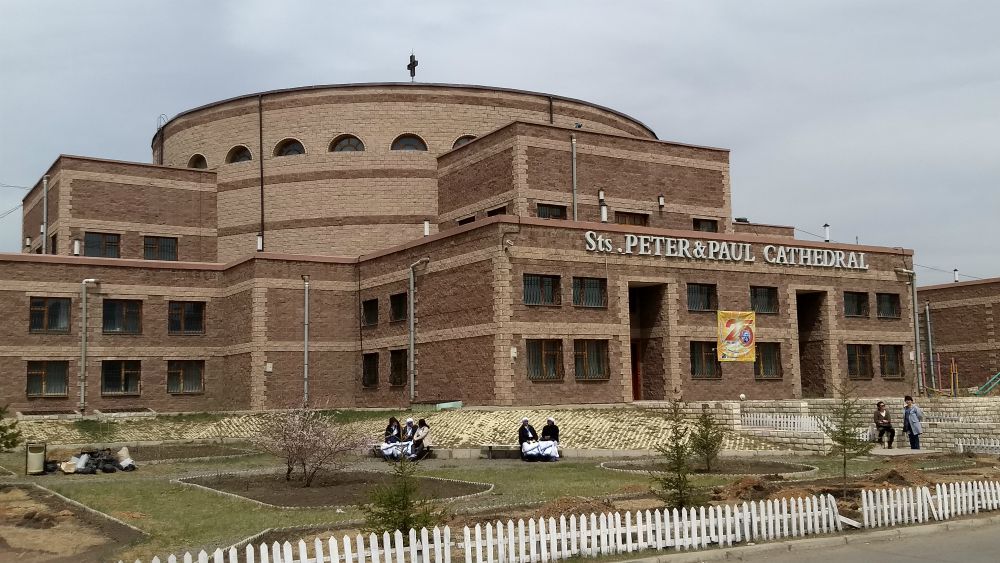
Bishop Wenceslao Padilla came to Mongolia first in July 1992. He is pictured speaking at a mission theolgy course Edmund Chia and Gemma Cruz were invited to teach recently. (Edmund Chia)
The Pontifical Missionary Union, one of the societies under the Vatican's Congregation for the Evangelization of Peoples, had asked us to present a course on mission theology for churches in Asia, which is how we found ourselves flying in to the Chinggis Khaan International Airport in Ulaanbaatar, the capital of Mongolia.
Gazing down as the plane made its approach, we had to ask ourselves what it would have been like to begin a new mission in this land of the founder of the Mongol Empire. We would find the answer to that question shortly, in the life-story of Bishop Wenceslao Padilla and how he has shepherded the youngest church on Earth for the last 25 years.
Wens, not yet a bishop, flew into the same airport in July 1992, shortly after the Vatican established diplomatic relations with Mongolia. When he arrived with two of his Missionhurst confreres, members of the Congregation of the Immaculate Heart of Mary, there was no church and no local Catholics to welcome them. He did, however, discover some expatriate Catholics, especially those working in foreign embassies. They began house-churches, taking turns to have Mass celebrated in one another's homes. Friends and colleagues came along, and as the numbers grew, community halls were rented for the Sunday services. It was only much later that brick-and-mortar churches were built to accommodate the growing membership.
What trigged the growth and expansion of the Catholic mission, however, was its involvement with society. The Soviet Union dominated Mongolia during most of the 20th century, so the Soviet collapse in the late 1980s left Mongolia's economy in turmoil, resulting in much poverty nationwide. The three missionaries soon found themselves involved with homeless people, in particular those who sought warmth and shelter in the underground drainage systems where heating pipes pass and rats and cockroaches proliferate. The missionaries would make their way into every manhole of the city in search of its "residents," offering them food, medicine and love. As their ministry expanded, they recruited their neighbors to assist in the distribution of food. The new volunteers then began asking questions about these noble missionaries — and what motivated them to care for the least, the last and the lost — and some eventually made their way to the church.
Advertisement
Today, 25 years later, several dozen missionaries have come from Africa, Asia, Europe and Latin America. They follow basically the same missiological principles that the first missionaries employed, founding technical schools, orphanages, homes for the aged, clinics, domestic violence shelters and kindergartens. These centers most often are set up in shanty towns and suburbs where basic services are lacking. The beneficiaries are people who are poor, and for every child the center enrolls, the Catholic mission is also able to reach out to the child's siblings, parents and extended family. They thus are in the service of the larger community, mainly in the diakonia ("service") ministry of providing care, healing and education. Only after several years of this evangelistic outreach is a church built.
As the Federation of Asian Bishops' Conferences have often taught, mission in Asia begins with being with the people, responding to their needs, and witnessing to the values of the reign of God here on Earth. This before-death salvation brought about by the disciples of Christ serves as foretaste and sign of God's kingdom that is to come in heaven. It may be years before a local community emerges and a church established.

The Cathedral of Sts. Peter and Paul was built in 2003 and is modeled after the traditional nomadic tent used in Mongolia. (Edmund Chia)
The establishment of the church, therefore, is a slow process and its growth gradual. The parish priest begins everything anew, literally from ground zero. Baptism certificates are printed with serial numbers beginning with 001. A parish priest mentioned that his first two certificates were issued to a native couple who had been enquiring about the Catholic faith while working abroad. They were the first in his community to be baptized and, shortly after, married in the church as well and so were issued with a marriage certificate also bearing the serial number 001. It might take a while for the parish to reach certificate number 999!
Like much of Asia, the church in Mongolia will probably always remain a small minority in the land where Tibetan Buddhism thrives and the locals are innately oriented towards the shamanic spirituality of their nomadic ancestors. Discipleship in Christ is certainly not a numbers game, but the church's minority status is a reminder that it serves as salt of the Earth. Salt has to be used in small in quantities, Bunluen Mansap, the late bishop of Ubon Ratchathani, Thailand, was fond of saying. Too much salt in the soup renders it awful!
In the context of Mongolia, the church, as a pusillus grex ("little flock"), has to engage in its mission through what the Asian bishops call the triple dialogue: dialogue with the cultures, the religions and the people who are poor. In other words, it has to be sensitive to and respectful of the local cultures and in partnership with the other religions as it goes about ministering to the many disenfranchised people in society.
As it celebrates its 25th anniversary, the Catholic Church in Mongolia can only be proud of the inroads it has made in gaining the trust of the people. It is slowly but surely developing into a local church, having enculturated significant aspects of the Catholic tradition. The Cathedral of Sts. Peter and Paul was built in 2003. It is modeled after the traditional ger (nomadic tent), with its circular shape and walls of thick felt. A Mongolian version of the Bible was printed in 2004 and includes common Catholic prayers, all written in the traditional Mongolian script. The six parishes in the country and the 1,300 baptized natives rejoiced at the ordination of the first native-born priest just a year ago, a young man baptized as a child by Bishop Wens many years ago.
So while we had come to Mongolia to teach course on mission theology, as we were flying out we realized that we were the ones who had learned how mission is actually done in Asia as evidenced by the praxes of the local church in Mongolia.
[Edmund Chia and Gemma Cruz are a married couple from the Australian Catholic University. Prior to migrating to Australia, Malaysian-born Chia taught at the Catholic Theological Union, and Philippines-born Cruz at De Paul University, both in Chicago.]







